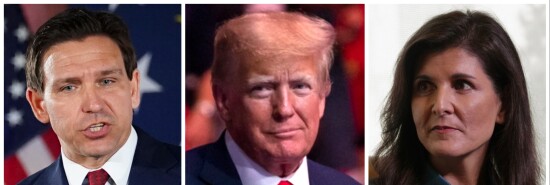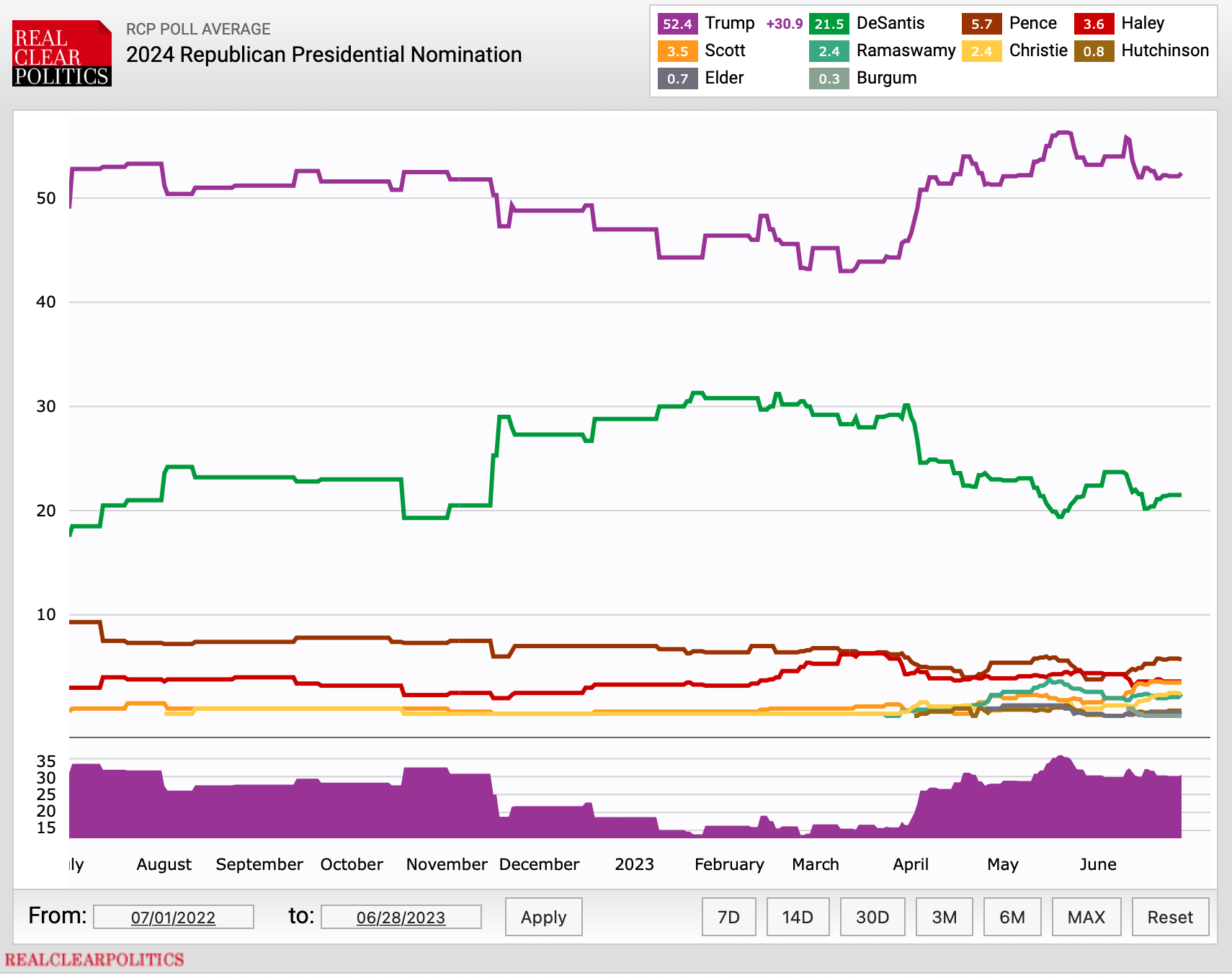
The shape of the GOP race so far
Byron York
THE SHAPE OF THE GOP RACE SO FAR. The Republican presidential field now includes a dozen candidates. It’s a bigger group than some anticipated. The field seems set, and the next big event will be the first GOP debate, to be held on Aug. 23 on Fox News.
The political world has been watching the race for a year, starting when the 2022 midterm elections were still in the campaign stage. Now that we’re able to look back over that period, we’re seeing the contours of the race and how it has changed over time. And it appears that for all the daily obsession with the latest news, just three events have had any significant effect on the contest.
Former President Donald Trump has led the whole way, of course. Looking at the RealClearPolitics average of polls beginning July 1, 2022, Trump had a 34-point lead over Gov. Ron DeSantis (R-FL). Trump had 52.8% of the vote in those national surveys, with DeSantis at 18.5%, and Mike Pence, Nikki Haley, and Tim Scott all farther back.

Subscribe today to the Washington Examiner magazine that will keep you up to date with what’s going on in Washington. SUBSCRIBE NOW: Just $1.00 an issue!
The situation remained remarkably stable for the next four months, with Trump over 50%, with a 30-plus point lead over DeSantis and Pence, Haley, and Scott trailing. Then came the first race-changing event, Election Day 2022, with disappointing performances by a few high-profile Trump candidates and, more importantly, DeSantis’s commanding 20-point victory in his run for reelection as governor of Florida.
Two things happened almost immediately: Trump dipped below 50% support in the RealClearPolitics average, and DeSantis shot up nearly 10 points. For the first time, the race seemed like a race. Republicans who wanted to move on from Trump were heartened. DeSantis, riding a wave of good coverage after his win, seemed like the man to beat Trump.
That continued for months. But DeSantis would only rise so high, and Trump would only fall so far. From mid-November 2022 until the end of March 2023, the newer, narrower race remained stable. At its closest point, in late February, Trump’s lead over DeSantis was 12.8 points. That was a lot closer than 30-plus points, but it was still a solid Trump lead.
Then the second race-changing event occurred. On March 30, Manhattan’s elected Democratic district attorney, Alvin Bragg, indicted Trump on 34 felony charges involving a payoff to porn star Stormy Daniels and the Trump Organization’s financial record-keeping. Many observers found the indictment weak — to this day, for example, we do not know what alleged offenses Bragg has relied on to upgrade misdemeanor charges into felonies. Beyond that, huge majorities of Republicans saw the indictment as politically motivated.
The race shifted immediately. Trump, who was at about 44% just before indictment, shot up above 50%. DeSantis, who had risen to 30%, fell to 25%. Trump’s lead over DeSantis, which had hovered around 30 points before DeSantis’s reelection and fell to around 15 points after, returned to the 30-point range.
Soon after, the third race-changing event occurred. It was not one single event but a series of developments involving lesser candidates. First, several new candidates entered: Asa Hutchinson, Chris Christie, Larry Elder, Francis Suarez, Doug Burgum, and others. Then, one candidate who had joined in February, entrepreneur Vivek Ramaswamy, made a small move upward in the polls.
None of that appeared to have any effect on Trump, who has moved around between 52% and 56% in recent weeks. But DeSantis has fallen further, at one point dipping below 20% support. He is now at 21.5%.
Finally, there was the big event that does not seem to have affected the race. On June 8, Trump announced that he had been indicted by Justice Department special counsel Jack Smith in the classified documents case. He thus became the first president or former president ever to face federal charges. The indictment accuses Trump of 37 felonies. By all accounts, it is more serious and carefully drawn than the Manhattan indictment.
But as far as the polls are concerned, the federal indictment seems to have had little effect on Trump’s standing. Trump dipped about 3 points in the RealClearPolitics average after the indictment but remained above 50% the whole time. There are various theories to explain this, the simplest being that Republican voters already saw Trump as having been unfairly targeted by the Justice Department and saw the Smith indictment as just one more unfair attack on the former president.
So that’s where the race is now. Trump had a 30-point lead before DeSantis’s reelection victory and the other elections last November. He had a 15-point lead after that, which jumped back to 30 points after the Manhattan indictment. It remains there today.
Will anything change that? Can anything change that? Who knows? There’s no doubt that a number of campaigns, rather than having some clear theory of the race, are simply pushing on in hopes that something will happen. Something will happen to make Trump implode, or Trump will begin a long, slow slide, or something. If that happens, the others want to be in a position to take advantage of it.
But right now, Trump has a lead over the Republican field that is somewhere between that of a dominant candidate and an incumbent president. His challengers are learning there is little they can do to change that. They’re just hoping that some external force, some deus ex machina, intervenes to shake up the race.
For a deeper dive into many of the topics covered in the Daily Memo, please listen to my podcast, The Byron York Show — available on the Ricochet Audio Network and everywhere else podcasts can be found. You can use this link to subscribe.
